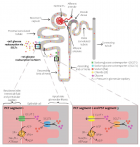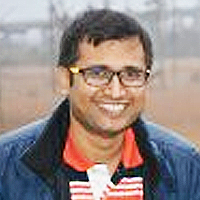Table of Contents
A trial of conservative care for restoring scapular dyskinesis: A clinical series
Published on: 8th June, 2020
OCLC Number/Unique Identifier: 8628657543
The shoulder is the greatest movable joint in the human body. Its anatomical design allows a wide range of motion in all directions, leading to an insubstantial balance between stability and mobility. Conservative treatments are suggested by a number of authors for restoring the scapular dyskinesis. However, this condition can be overlapped by other clinical findings. Therefore, comprehensively analysing individual biomechanical rationale is central to design the ideal rehabilitation regimen to overcome scapular dyskinesis by restoring the scapular thoracic rhythm and preventing the associated problems. This study presents a brief clinical series of three patients with shoulder pain due to the alteration of their scapulahumeral rhythm and highlights a comprehensive examination and follow up an evidence-based rehabilitation algorithm to regain pain free functional ability in daily routine life.
Contemporary learning or E-Learning in physiotherapy, pre and post COVID-19: Short communication
Published on: 18th May, 2020
OCLC Number/Unique Identifier: 8605488147
Since December 2019, an outbreak of novel corona virus disease was reported in Wuhan, which has subsequently affected more than 160 countries worldwide. The ongoing outbreak has been declared as a pandemic by WHO, a global public health emergency. Several countries are successfully fighting with the pandemic by taking strict measures like nationwide lockdown or by sequestering the areas that were suspected of having risk of community spread. The corona virus pandemic has upended our educational system worldwide [1-3].
The academic calendar all over the world has been disturbed as a result of lockdown. Even after lockdown it would take probably many more months for universities, colleges and schools to reinstate. Caught in the turmoil, some parts of urban Indian education system have turned towards delivery of education via internet or online education. The NCAER skills report 2018 discussed the immense potential of online learning, conversely as complementary to more traditional methods. Centuries old, lecture based approaches, institutional biases, and outmoded classrooms changed. Covid 19 has become an impetus for educational institutions worldwide to search for innovative solutions in a relatively short duration. In the prevailing situation, online education is turning out as an alternative to traditional modes [2,4,5].
Contemporary/E-learning prepares students across all curriculum and learning stages with skills and potential to flourish in a rapidly changing and interlinked world. It connects students and engages their sense of inquisitiveness. E-teachers know and understand the needs and talents of their students. They are trained, flexible and select from a wide range of effective teaching strategies based on need. The new learning environment and resources galvanize students to be leaders of their independent learning. Thus students collaborate and use critical and creative thinking to solve complex problems and become apprehensive and sentient global citizens [4-6]. In physiotherapy, apart from traditional institution based learning, there implies a need for technological inputs and E-learning as a need to develop critical, creative thinking and reasoning. These technological arrays do provide better concepts and understanding regarding academics and practice [6]. As physiotherapy is advancing and growing in academics, research and practice, the need for an interlinking platform through which learning becomes unconditional and globally accessible was never addressed. Covid- 19 lockdown and strategies imposed us to think apart from institutional mode, ostensibly got a worldwide acceptance.
Research suggests that online learning has been shown to increase retention of information, and take less time. On average, students retain 25% - 60% more information when learning online compared to only 8% - 10% in a classroom. E-learning requires 40-60% less time to learn and understand than in a traditional setting, because students can learn at their own pace, re-reading, skipping or accelerating through concepts as they choose. Contemporary learning or E-learning at present situation is intended to have the desired effect such as physical distancing, schedule flexibility, cost effective, fast learning, course variety, boost memory, reasoning and innovative teaching [2,4].
Adoption of online learning will continue to persist post pandemic, and how such a shift would impact the worldwide education market should be studied. Some believe that the unplanned and rapid move to online learning with no training, insufficient bandwidth, and inadequate preparation will result in a poor user experience that is deleterious to sustained growth [5,8]. The current crisis has acted as a thwack to encourage digital education among physiotherapy institutions. However, to achieve its prospective in the long run, physiotherapy institutions and universities should implement a digital platform, training as well as a curriculum regulation. “We believe that, the integration of information technology, E-learning in education will be further accelerated and eventually transpire to an integral component of physiotherapy education and practice”.
Neuroanatomical profile of hemineglect in patient’s body image modification
Published on: 26th March, 2020
OCLC Number/Unique Identifier: 8560711773
Background: NSU is generally caused by right cerebral hemisphere lesions with a preeminent localization on the frontoparietal lobe.
Aim: To assess the correlation between the typology and the brain lesion site and the consensual consent modality of body image modification after an integrated rehabilitative and neuropsychological treatment.
Setting: A rehabilitation institute for the treatment of neurological gait disorders and neuropsichological failures.
methods: Patients recruited were divided according to the brain lesion site into 3 groups (IG = ischemic group = 5 patients; HG = hemorrhagic group = 4 patients; IG + HG = ischemic + hemorrhagic group = 3 patients) based on CT brain performed in the post-acute phase. At time T0, the patients recruited underwent a systematic review of their current neuroradiological profile (location delineation and type of brain injury) compared with a consensual framing of the neuromotor and neuropsychological profile acquired at the time of taking charge in the ward. At time T1 and after the drafting and implementation of the rehabilitation treatment plan foreseen in the study (1 to 4 months after T0), the patients in our sample underwent a re-evaluation of their neuromotor and neuropsychological profile with controls of the same outcome parameters considered at time T0.
Results: A parametrically but not statistically significant modification of the results obtained was observed by measuring the MI ULl, MI LLl and TCT scales in the group with hemorrhagic brain injury; the analysis of variance did not show any statistical significance in the relationship between the type of stroke (ischemic, hemorrhagic or both) and the motor impairment passing from time T0 to time T1. The analysis of variance did not reveal a statistically or parametrically significant relationship between the type (ischemic, hemorrhagic and ischemic + hemorrhagic) of cerebral stroke and the variations of the neuropsychological profile. The T-Student test showed statistically significant changes in the importance of the lesion site in defining the degree of motor disability. In particular, we observed, about the presence of frontal lobe lesions, a statistically significant variation passing from the T0 time to the T1 time for the following motor scales in 9 of 12 recruited patients: MI LLl (26.4 vs. 62, with p < 0.05), TCT (43.6 vs. 80.6, with p < 0.01 for equal variance assumed and p < 0.05 for equal variance not assumed), FAC (0.8 vs. 2.3 with p < 0,01 for equal variance assumed and p < 0.05 for equal variance not assumed).
Conclusion: We have confirmed the importance of the anatomical-dysfunctional correlation as a key concept from which to start in any neurorehabilitative treatment approach. Our work has highlighted the basic role of the right frontal lobe in the programming and execution of the gesture and its kinesthetic control as regards the left lower limb and the trunk.

If you are already a member of our network and need to keep track of any developments regarding a question you have already submitted, click "take me to my Query."


















































































































































